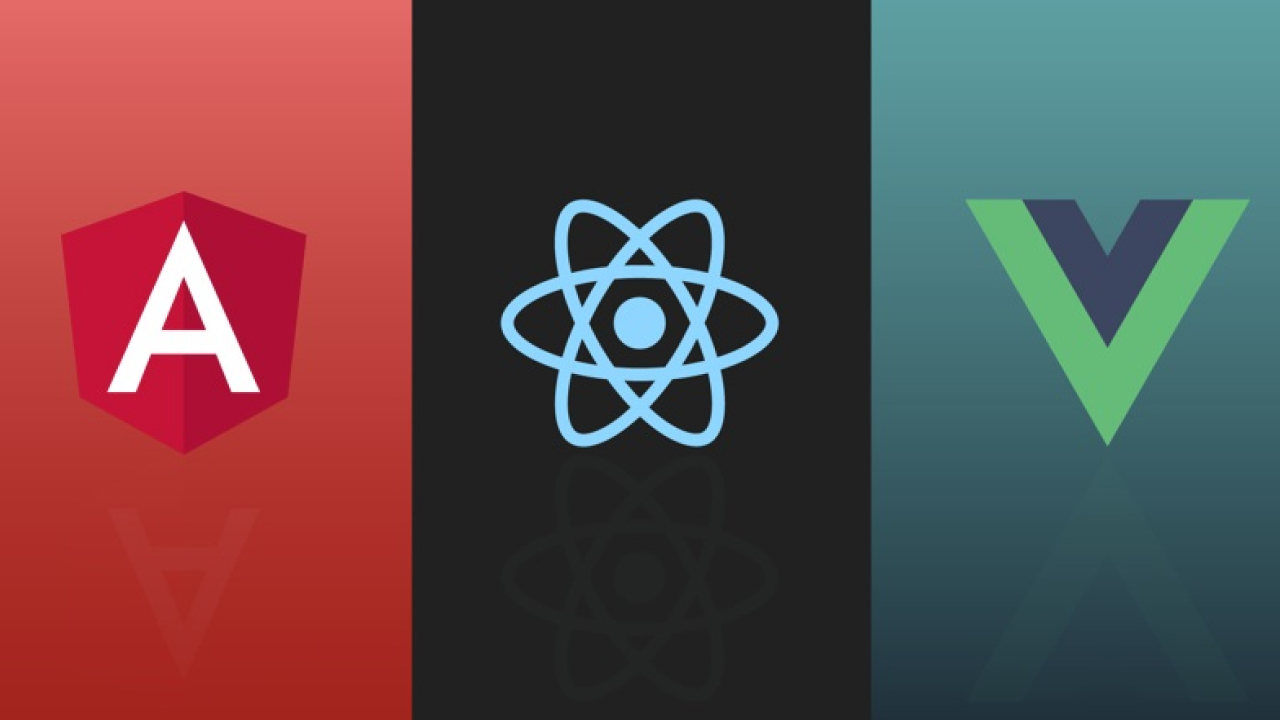JavaScript has been used for over a quarter of a century, and its frameworks are still popular. They are in demand by about 70% of developers because they are the tools that bring a maximum return. All of them are steadily evolving, helping to solve the most complex tasks of a wide range. Is there a universal one among them? Perhaps there are all of them. But is there the best one?
We at EXB Soft use all JS frameworks, so we know when and which one is the best. We will tell you about each one and compare angular vs react vs vue to make it easier for you to choose which one to use.
Angular vs Vue vs React: General characteristics
One is old, but well-tested. The other - is ambiguous, but very popular. And the third promises to be the most promising. But all are good in their own way.
React: no longer the leader?
Developers love this rich environment, so React occupied the first lines of the ratings until recently. It is noteworthy that, in fact, it is a user interface library. But with so much functionality, one can use it without additional integrations.
Without it, there would be no Instagram, Whatsapp, or Twitter. One of the critical reasons for the high trust is the support of Facebook, which has been releasing too many updates lately. Therefore web developers have to learn new methods and completely rewrite the code, which reduces the appeal of React to a certain extent.
Why is Vue ahead of the curve?
The progressive framework has become a discovery of recent years and one of the most beloved among professionals. Notably, its popularity has grown without the support of the giant companies that use it today (Xiaomi, etc.).
Vue is very flexible, but learning the tricks of using it requires knowledge of the Chinese language. It is in high demand in the Asian market and is regularly updated, so its popularity is growing exponentially.
What is Angular valued for?
It is a full-scale front-end framework, long considered the best for UI. But now, many are abandoning it because of new development trends that competitors can handle better. However, it continues to be widely used to support many popular websites and applications.
React vs Vue vs Angular: Features
All three frameworks can be used almost interchangeably, but each has different parameters and tools.
Architecture
React
Elements are the basic building blocks of applications. Because the React DOM provides updates, they are more powerful tools than the standard ones.
Components are reusable throughout the application. They take input data (props) and create elements that are later presented to the user. APIs and blocks written with JSX are compatible, but for the most part, JSX is more user-friendly, avoiding writing long code and unintuitive HTML element creation. Supports TypeScript.
Vue
The framework is called progressive because its functionality can be extended with libraries. You can work at the View level here to ensure that data is handled in a way that displays the actual view and state of the application with a minimum of re-rendering.
You can create components by combining HTML with special directives and features, although pure JavaScript and JSX are also supported. Unique is the Single File Component (SFC), which consists of three parts:
- Template (written in an extended version of HTM) - Provides final component markup based on internal state. It allows you to create markup relative to conditions or dynamically with directives (v-if, v-for, etc.).
- Script - designed to write the logic and control the component's state. You can optionally use JavaScript and TypeScript.
- Style - holds CSS. Written styles are encapsulated in the component and do not affect the rest.
The ability to put all the necessary code for component functionality in a single file provides convenience. For application rendering, it's better to use the main App.vue component.
Angular
Built on TypeScript, although it supports regular JS. Angular 2 has no strict connection to MV* patterns, as it is based on components and modules.
Each component contains a template, logic with metadata, and optionally styles, separated into separate files. The templates are written in HTML. The scope is determined by modules capable of importing and exporting functionality. The best option is to use structure applications as a set of individual services that can be reused.
Ecosystem
You can save application development time by using open-source software. But it is essential to consider the availability of tools.
React
This is where the official React-building for Redux is often used. It is easy to find ready-made components and packages on Google or Github. React Native allows you to create native mobile applications.
Vue
Although Redux can be used, there are no official bindings. But there is Vuex, its official analog. In addition, there is already a wide range of components and libraries that can be used.
A project called Weex by Alibaba has been designed for mobile application development. Vue integrates well with Laravel, which fully supports JS and CSS. But since it is used more in China, finding documentation takes a lot of work.
Angular
It is part of the MEAN stack, relying entirely on JS for both the front-end and back-end. There is an official NgRx project for state management. Ready-to-use components are easy to import. Optimal for cross-platform applications - NativeScript, as Angular support is well developed.
Performance
This criterion may be satisfactory if we are talking about a small project. However, performance will become an issue as its scale and complexity increase.
Vue
In terms of page response, it is the fastest. It handles string swaps better. It has high memory usage and initialization speeds. It has a Server-Renderer SSR package by default, but there can be problems with virtualization due to the lack of stability of the Virtual Scroll List.
React
Handles page loading and rendering well. Has an official server-side ReactDOMServer package and its own virtualization library by default.
Angular
It has a particular module for server-side rendering and built-in components for virtualization. However, it is inferior to competitors. It is more demanding on memory because it is a full-fledged framework.
Vue vs React vs Angular: learning complexity
This aspect is essential when choosing a framework for beginners.
React
At first glance, the easiest to use. It is enough to import the library, and you can write code in JS using React API. However, even the simplest looks awkward. It would help if you learned JSX because its use is necessary to create HTML layouts for components.
On the other hand, starting with version 16.8, React functional components are available, simplifying the syntax and allowing you to quickly create components as simple ES6 arrow functions with a typical JSX layout in the return value. And version 17.0 can partially upgrade your application, allowing you to keep functionality on legacy concepts.
Vue
Beginning developers need an introduction to advanced HTML syntax with directives. Most of the primary directives are intuitive:
- v-if - for rendering provided,
- v-for - for rendering in a loop,
- v-on - for bindings to event listener functions, etc.
Having layout, functionality, and styles in a single file with an intuitive syntax makes it easy to create components. The release of Vue 3 solved many usage issues for large projects by introducing greater reuse of functionality between components. It also improved project support with TypeScript source code refactoring.
Angular
Developers will have to stick to a particular structure in writing code and use components and modules with services all the time. They need to learn additional HTML syntax from ng-* directives. The framework works best with TypeScript, which is also a must-have. It is also vital to know the RxJS library, which will allow you to organize your work with events and asynchronous code conveniently.
This framework has a vast community. That said, the difficulty of upgrading projects to new versions puts it at a disadvantage. Although it is still popular for large projects, more and more developers (especially for startups) prefer to use the capabilities of competitors.
Pros and cons
According to surveys, developers love them more than they fear them. And this is for a reason because the advantages always outweigh the disadvantages, both real and imaginary
React
Benefits:
- Component reuse;
- Downstream data flow;
- Fast content loading;
- Improved search engine ranking (search bots see a fully rendered page);
- Easier to build mobile apps based on an out-of-the-box REST-API;
- Huge community.
Disadvantages:
- Difficult JSX syntax;
- Focus on UI.
Vue
Strengths:
- Reinforced HTML;
- Good documentation;
- Fast scalability and adaptability;
- Small size.
Disadvantages:
- Lack of resources to integrate into massive projects.
Angular
Positives:
- Exceptional Typescript support;
- Intelligent features and auto-complete template HTML component;
- Detailed documentation;
- Structure and architecture designed for greater project scalability.
Negatives:
- Challenging to learn due to the abundance of structures;
- Relatively poor performance.
React vs Angular vs Vue: When is Best?
All are popular among developers, and it remains to find out which one copes with what tasks best at this stage of its development.
React
It has less boilerplate, and it's easier to shape and track redrawing of elements on the changes in the state. As a result, the standard UI routine is times faster and more comfortable. Despite the many advantages, there are only a few cases for which this development environment is ideal:
- Development of enterprise applications and SPAs;
- Extension of existing functionality.
This means that it is okay for other tasks. Rather, the alternatives will prove to be preferable.
Vue
Its benefits are best seen in projects such as admin windows, online editors and filters in an online store, checkout forms, etc. It's excellent with animated transitions between blocks, interactivity, asynchronous calls, and graphing. This option is exceptionally well suited for "from scratch" development:
- "Smart" and native applications;
- Small, single-page, lightweight, feature-rich Internet applications that require an early release.
This choice is best in all cases where there is an input/block whose content is related to some data changing in another input/block and where asynchrony is needed. That is, for the most part - for working with data. If you need to build a comment tree based on data dynamically, vue does it best.
Angular
This solution is suitable where there is a possibility to spend a lot of time to bring the various "zoo" solutions to a standard style and architecture. It is typically used to implement the following:
- Scalable architecture;
- Real-time applications;
- Messengers.
It requires a setup, but it answers most questions out of the box, allowing the developer to relax.
Conclusions
It's impossible to predict the long-term relevance of any of these frameworks, but it's important to note that Angular is growing slower than it once did. React is still a frequent choice, but it no longer dominates. On the other hand, Vue is rapidly evolving, adopting practical concepts from competitors.
Each candidate in the vue vs angular vs react comparison has its pros and cons. One has to choose the tools for the project. When choosing, it's essential to determine its complexity, direction, and scale, as well as the team's experience and ability to train it if necessary.
Our team will gladly help you with this. By contacting us, you are guaranteed to get the best solution or experts to help create it.
F.A.Q
Vue is known for its flexibility and progressive nature, React is a rich environment backed by Facebook, and Angular is a full-scale front-end framework. Each has its unique strengths and can be chosen based on specific project needs.
React uses components and elements, focusing on JSX and TypeScript. Vue offers Single File Components combining template, script, and style. Angular is based on TypeScript, using components and modules with templates written in HTML.
React has a strong ecosystem with tools like Redux and React Native. Vue offers Vuex for state management and integrates well with Laravel. Angular is part of the MEAN stack and supports cross-platform development with NativeScript.
Angular is often chosen for large-scale and complex projects due to its robust structure, TypeScript support, and built-in components for virtualization and server-side rendering.
React is straightforward but requires learning JSX. Vue is intuitive with directives and single-file components. Angular has a steep learning curve due to its complex structure, TypeScript, and additional libraries like RxJS.
React offers component reuse and fast content loading but has complex JSX syntax. Vue is scalable and fast but may lack resources for large projects. Angular supports TypeScript and scalable architecture but is challenging to learn and has relatively poor performance.
Choose React for enterprise applications and SPAs, Vue for small, single-page, feature-rich applications with dynamic content, and Angular for scalable architecture and real-time applications like messengers.



